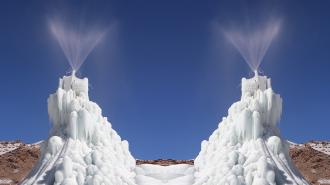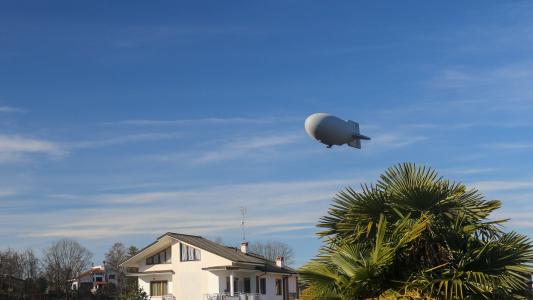This article is an installment of Future Explored, a weekly guide to world-changing technology. You can get stories like this one straight to your inbox every Thursday morning by subscribing here.
In recent years, mountain communities in Chile have been facing longer and more intense dry spells thanks, in part, to rapidly shrinking glaciers in the Andes. This puts serious stress on local communities that rely on their fresh water.
But a team of Chilean climate experts have come up with a solution. In 2022, they will attempt to DIY their own glaciers, in hopes of supplying fresh water through the dry, summer months.
Why this matters: The world’s glaciers are melting — collectively they are losing an average of 1.2 trillion tons of ice per year. This massive thaw is creating problems for the 1.9 billion people around the world that rely on glaciers for drinking water or crop irrigation.
But small man-made glaciers — also known as ice stupas — could help to mitigate the effects of climate change and provide support to vulnerable populations around the world.
“We are looking for a solution that actually allows us to protect water for a longer time in the mountain range, and then deliver it to communities downstream,” Enrique Gellona, director of the project in Chile, told Reuters.
“High school math told me that a cone was the simple answer.”
Sonam Wangchuk
The inspiration: The Chilean initiative — called the Nilus project — was inspired by a similar initiative in Ladakh, India, where the world’s first ice stupa was built in 2013. Similar to communities in Chile, residents there are dependent on Himalayan glaciers and snow melt for their livelihoods.
Sonam Wangchuk, the engineer for the project, developed the idea of artificial glaciers after noticing that ice can stay frozen in Ladakh (a cold desert environment in the winter) into the summertime, as long as it’s well-shaded.
“High school math told me that a cone was the simple answer,” Wangchuk told Outside Online. The shape of a cone — particularly a steep cone — naturally provides shade to its own interior.
How it works: The stupas are a really simple yet remarkable engineering feat.
The cone-shaped base of the stupa is made of wood and steel. The stupa is usually built at low altitudes, next to a village. A long, underground pipe diverts water from local streams at high altitudes during the wet season, channeling it downward toward the village. Then at night when the temperatures drop, the water is released from a vertical pipe, shooting into the air like a fountain.
“These ice stupas are built next to where the water is needed most.”
Matteo Spagnolo
Thanks to the sub-zero temperatures, the water turns to ice and is quickly frozen onto the base — creating a cone.
“A cone is very easy to make with ice, because any dripping naturally forms a cone underneath — icicles are inverted cones,” said Wangchuk.
And because a cone has a relatively small surface area, most of the ice is not exposed to the sunlight at all. That means it melts really slowly, a feature that allows for the stupas to be built at lower altitudes.
As the weather warms and the streams dry up, the melting ice provides the community with drinking water and an extended growing season.
“This would serve to supply more or less a community of 100,000 people for three months.”
Roberto Lara
While these artificial glaciers have been built since 2013, the construction and design is becoming much more efficient. In the past, the shapes and location of the stupas — high up in the mountains — made them difficult to manage, writes Matteo Spagnolo, professor of Geography and the Environment at the University of Aberdeen.
“Now, these ice stupas are built next to where the water is needed most, right on the outskirts of villages, near their fields. The size and shape make them particularly efficient, inexpensive and easy to maintain, and they are able to produce millions of litres of water each year.”
The Nilus project: In 2022, the Chilean team plans to build 50 ice stupas in order to store a total of 100 million liters (26.4 million gallons) of water.
That’s a far cry from the size of the natural glaciers that carved the mountain valleys — but it’s enough to supply small communities.
“This would serve to supply more or less a community of 100,000 people for three months,” Nilus engineer Roberto Lara told Reuters.
The prototype for the project is already underway, according to Reuters, in the Cajon del Maipo mountain range located southeast of Santiago.
“We are trying to foster innovation, so that other ideas can come out of it.”
Simant Verma
Onward: While huge natural glaciers are shrinking, mini man-made glaciers are catching on. What started as a single stupa in 2013 has since grown, both in the Himalayan region and beyond. Aside from the Chilean project, stupas have been made in the Alps and, according to the New Yorker, Canada is considering building them too.
This simple innovation is changing lives in dry, rural regions around the world. Still, stupas are far from the solution to the negative effects of climate change on glaciers — but the beauty of innovation is that ideas spur other ideas, and before you know it, you’re getting traction on the problem.
“We don’t look at ice stupas as just a solution to climate change,” said Simant Verma, an ice stupa project manager. “That’s not how we’re trying to put this out in the world. We are trying to foster innovation, so that other ideas can come out of it.”
We’d love to hear from you! If you have a comment about this article or if you have a tip for a future Freethink story, please email us at [email protected].






